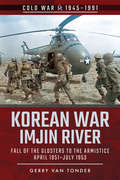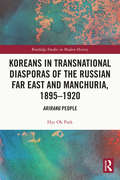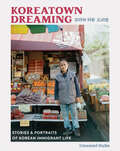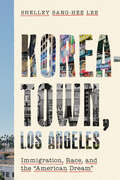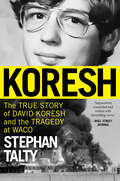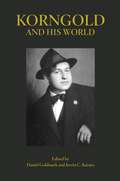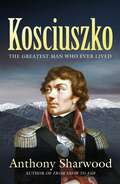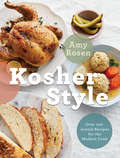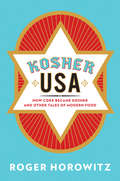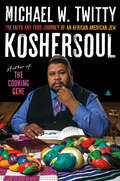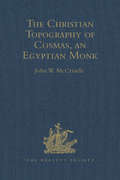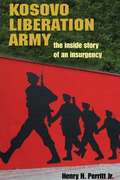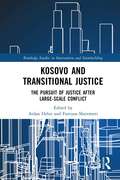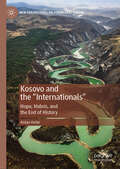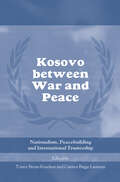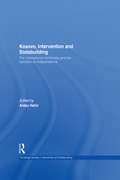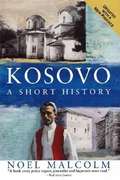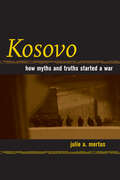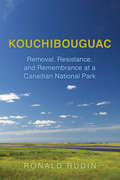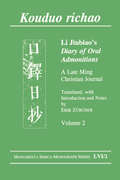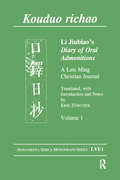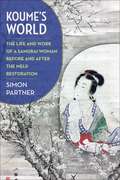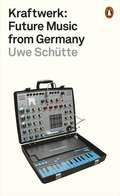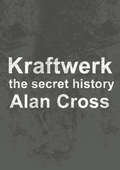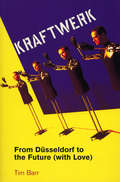- Table View
- List View
Korean War—Imjin River: Fall of the Glosters to the Armistice, April 1951–July 1953 (Cold War, 1945–1991)
by Gerry van TonderAn in-depth look at the disastrous consequences of misjudgment and impulsiveness by the United States during the Korean War.As of October 1950, a quarter of a million Communist Chinese troops, in twenty-seven divisions, had poured across the Yalu River into North Korea, with the singular objective of forcing General Douglas MacArthur’s United Nations troops back across the 38th Parallel and into the Sea of Japan.Shortly before midnight on April 22, 1951, to the west of the U.S. Eighth Army’s defensive front, the Chinese Sixty-third Army fell on the British 29th Brigade. On the left flank, the 1st Battalion, Gloucester Regiment (“Glosters”) held a tenuous position at a ford on the Imjin River. Despite a gallant defense, the battalion was pushed back to make a desperate but futile stand on Hill 235. On what became known as “Glosters’ Hill,” the battalion ceased to exist. It was subsequently estimated that the attacking force of 27,000 Chinese troops suffered 10,000 casualties, forcing the Chinese army to be withdrawn from the front.From August 1951 to the summer of 1952, the USAF conducted Operation Strangle in a futile and costly attempt to disrupt Chinese supply routes. In the last two years of fighting, Communist Chinese and UN forces faced each other from well-entrenched positions in hilly terrain, where mapped hill numbers were contested. From June 1952 to March 1953, a series of five hard-fought engagements took place in central Korea as the antagonists sought ownership of Hill 266, commonly referred to as “Old Baldy.” This was followed during April–July 1953 by two tactically pointless battles over Pork Chop Hill, in which the UN forces won the first battle and the Chinese the second, with both sides sustaining major casualties. On July 27, 1953, the two belligerents signed an armistice agreement, implementing a ceasefire that stands to this day. De facto, the Korean War has never ended.
Koreans in Transnational Diasporas of the Russian Far East and Manchuria, 1895–1920: Arirang People (Routledge Studies in Modern History)
by Hye Ok ParkMuch attention has been paid to the Japanese deployment of Koreans in their war efforts during WWII. Much less attention, however, has been given to the subject prior to 1910. This book will: 1) present the evidence which reveals the presence of Koreans in the Japanese military during the Russo-Japanese War, 1904–1905, as seen by an American novelist Jack London, before the formal annexation of Korea by Japan, 2) analyze the presence of Koreans on the Japanese and the Russian sides of the war, and 3) investigate why and how these Koreans became involved in someone else’s war. Arirang, a Korean folksong favored and sung by Koreans at home and in exile, has sustained the Korean people in a shared, collective spirit throughout their lives in transnational diasporas in the Russian Far East, Manchuria, and Japan as well as in Korea. This is a study of transnational Koreans as the Arirang people: Chapter 1: Introduction, Chapter 2: Koreans in the Russian Far East and Manchuria, Chapter 3: Koreans in the Russo-Japanese War in 1904–1905, Chapter 4: Korean Transnationals as Stateless People, 1906–1920, and the Conclusion.
Koreatown Dreaming: Stories & Portraits of Korean Immigrant Life
by Emanuel HahnExplore and celebrate Korean culture in America through photographs and interviews by award-winning photographer Emanuel Hahn. "Photographer Hahn's animated and vivid debut . . . is exceptional." —Publisher's Weekly, Starred Review Since the first wave of Korean immigration in the early 1900s, Korean immigrants have opened and operated small businesses across the country that enrich the cultural fabric of our communities. Yet their stories are too often overlooked, as even today their existence is being pushed to the margins of American society. In Koreatown Dreaming, a project that began in Los Angeles and expanded to eight other cities, the lives of Korean immigrants are observed with care and admiration under Hahn's tender, capacious gaze. Hahn's arresting photographs and narrativized interviews portray Korean small business owners as key figures not just in their neighborhoods but in their own lives, where they experience personal struggle, sacrifice, triumph, growth, and joy.Koreatown Dreaming is at once an anecdotal history of Korean immigration and a touching homage to Korean immigrant life. These intimate stories of over 50 small businesses are a testament to the American Dream, even while complicating the illusions of that promise, and of what it means to be American. Cities featured: Los Angeles, California; Atlanta, Georgia; Annandale, Virginia; New York, New York; Flushing, New York; Pal Park, New Jersey; Fort Lee, New Jersey; Dallas, Texas; Honolulu, Hawaii.
Koreatown, Los Angeles: Immigration, Race, and the "American Dream" (Asian America)
by Shelley Sang-Hee LeeThe story of how one ethnic neighborhood came to signify a shared Korean American identity. At the turn of the twenty-first century, Los Angeles County's Korean population stood at about 186,000—the largest concentration of Koreans outside of Asia. Most of this growth took place following the passage of the Hart-Celler Act of 1965, which dramatically altered US immigration policy and ushered in a new era of mass immigration, particularly from Asia and Latin America. By the 1970s, Korean immigrants were seeking to turn the area around Olympic Boulevard near downtown Los Angeles into a full-fledged "Koreatown," and over the following decades, they continued to build a community in LA. As Korean immigrants seized the opportunity to purchase inexpensive commercial and residential property and transformed the area to serve their community's needs, other minority communities in nearby South LA—notably Black and Latino working-class communities—faced increasing segregation, urban poverty, and displacement. Beginning with the early development of LA's Koreatown and culminating with the 1992 Los Angeles riots and their aftermath, Shelley Sang-Hee Lee demonstrates how Korean Americans' lives were shaped by patterns of racial segregation and urban poverty, and legacies of anti-Asian racism and orientalism. Koreatown, Los Angeles tells the story of an American ethnic community often equated with socioeconomic achievement and assimilation, but whose experiences as racial minorities and immigrant outsiders illuminate key economic and cultural developments in the United States since 1965. Lee argues that building Koreatown was an urgent objective for Korean immigrants and US-born Koreans eager to carve out a spatial niche within Los Angeles to serve as an economic and social anchor for their growing community. More than a dot on a map, Koreatown holds profound emotional significance for Korean immigrants across the nation as a symbol of their shared bonds and place in American society.
Koresh: The True Story of David Koresh and the Tragedy at Waco
by Stephan Talty"Impressively researched and written with storytelling verve. ... Talty delves the deepest into the history and twisted personality of David Koresh." —Wall Street JournalThe first comprehensive account of David Koresh’s life, his road to Waco, and the rise of government mistrust in America, from a master of narrative nonfictionNo other event in the last fifty years is shrouded in myth like the 1993 siege of the Branch Davidians in Waco, Texas. Today, we remember this moment for the 76 people, including 20 children, who died in the fire; for its inspiration of the Oklahoma City bombing; and for the wave of anti-government militarism that followed. What we understand far less is what motivated the Davidians’ enigmatic leader, David Koresh.Drawing on first-time, exclusive interviews with Koresh’s family and survivors of the siege, bestselling author Stephan Talty paints a psychological portrait of this infamous icon of the 1990s. Born Vernon Howell into the hyper-masculine world of central Texas in the 1960s, Koresh experienced a childhood riven with abuse and isolation. He found a new version of himself in the halls of his local church, and love in the fundamentalist sect of the Branch Davidians. Later, with a new name and professed prophetic powers, Koresh ushered in a new era for the Davidians that prized his own sexual conquest as much as his followers’ faith. As one survivor has said, “What better way for a worthless child to feel worth than to become God?”In his signature immersive storytelling, Talty reveals how Koresh’s fixation on holy war, which would deliver the Davidians to their reward and confirm himself as Christ, collided with his paranoid obsession with firearms to destructive effect. Their deadly, 51-day standoff with the embattled FBI and ATF, he shows, embodied an anti-government ethic that continues to resonate today.Now, thirty years after that unforgettable moment, Koresh presents the tragedy at Waco—and the government mistrust it inspired—in its fullest context yet.
Korngold and His World (The\bard Music Festival Ser. #45)
by Kevin C. Karnes Daniel GoldmarkA brand-new look at the life and music of renowned composer Erich Wolfgang KorngoldErich Wolfgang Korngold (1897–1957) was the last compositional prodigy to emerge from the Austro-German tradition of Mozart and Mendelssohn. He was lauded in his youth by everyone from Mahler to Puccini and his auspicious career in the early 1900s spanned chamber music, opera, and musical theater. Today, he is best known for his Hollywood film scores, composed between 1935 and 1947. From his prewar operas in Vienna to his pathbreaking contributions to American film, Korngold and His World provides a substantial reassessment of Korngold’s life and accomplishments.Korngold struggled to reconcile the musical language of his Viennese upbringing with American popular song and cinema, and was forced to adapt to a new life after wartime emigration to Hollywood. This collection examines Korngold’s operas and film scores, the critical reception of his music, and his place in the milieus of both the Old and New Worlds. The volume also features numerous historical documents—many previously unpublished and in first-ever English translations—including essays by the composer as well as memoirs by his wife, Luzi Korngold, and his father, the renowned music critic Julius Korngold.The contributors are Leon Botstein, David Brodbeck, Bryan Gilliam, Daniel Goldmark, Lily Hirsch, Kevin Karnes, Sherry Lee, Neil Lerner, Sadie Menicanin, Ben Winters, Amy Wlodarski, and Charles Youmans.Bard Music Festival 2019Korngold and His WorldBard CollegeAugust 9–11 and 16–18, 2019
Kosciuszko: The incredible life of the man behind the mountain
by Anthony SharwoodHeroes are hard to come by - but there's one man whose legend has stood the test of two centuries, and whose name sits on Australia's highest peak. Tadeusz Kosciuszko: freedom fighter, friend of Thomas Jefferson and champion of liberty on two continents. Bestselling author Anthony Sharwood finds out why he's the hero the world needs right now.Kosciuszko - our iconic highest mountain - is a name familiar to all Australians. But how many people know who the mountain is named after?Tadeusz Kosciuszko, who lived from 1746 to 1817, is the most famous person Australians probably know absolutely nothing about. A military engineer, freedom fighter, and champion of human rights, this extraordinary revolutionary was crucial to the success of the American War of Independence, then bravely led an uprising against Russia and other invaders in his native Poland, promising freedom and equality to all who joined his cause.In his day, Kosciuszko was loved and respected across Europe and America. His great friend Thomas Jefferson called him 'as pure a son of liberty as I have ever known', while Kosciuszko would later challenge Jefferson to live up to the famous words 'All men are created equal' by bequeathing his American funds to free enslaved people, including those on Jefferson's plantation.Bestselling author Anthony Sharwood (From Snow to Ash; The Brumby Wars) has spent a lifetime walking, skiing and writing about Kosciuszko National Park. Now he sets off on the trail of the man himself, travelling across the USA, Poland and Switzerland to key sites in Kosciuszko's life. Returning to Australia where a potential name change from Mt Kosciuszko to an Indigenous name is hotly debated, he walks with the area's traditional owners and discovers the ancient history of Australia's highest peak.Kosciuszko's life and legacy is enthralling, inspiring and indispensable. But is that reason enough to keep his name on the mountain?
Kosher Style: Over 100 Jewish Recipes for the Modern Cook
by Amy RosenFor the bubbes and the balabustas, the keepers of Jewish kitchens and the enthusiastic neophytes, comes a cookbook that celebrates how many Jews eat today.In the Jewish culture, as in many others, bubbes, saftas and nanas are the matriarchs of the kitchen and thus the rulers of the roost. They are culinary giants in quilted polyester muumuus and silk slippers who know how to make the Semitic linchpins cherished from childhood--the kugel, the gefilte fish, the matzah ball soup and the crispy-skinned roasted chicken. They all have their specialties but, of course, they won't be around to feed us forever, and that will be a loss indeed. But it will be an even bigger loss if the recipes we grew up on pass away with them, along with those special connections to our past. That's what prompted Amy Rosen, journalist and cookbook author, to spirit the classic recipes from her grandmothers and other role models into the 21st century. All of the dishes in Kosher Style are inspired by the tables and tales and chutzpah of the North American Jewish experience. They also happen to be kosher. In this book are all the recipes you need for successful shellfish- and pork-free home entertaining, be it for a Jewish holiday or a workaday dinner. From crave-worthy snacks to family-size salads, soulful mains to show-stopping desserts, all of the recipes are doable in the home kitchen and are clearly marked as either a meat dish, dairy dish, or pareve (neutral). Think: Lacy Latkes & Applesauce, Sour Cream & Onion Potato Knishes, General Tso's Chicken, and Toblerone-Chunk Hamantaschen your family will plotz over. In addition to the classics, Amy has included some of her favorite modern recipes, like a Quinoa-Tofu Bowl with Greens & Green Goddess Dressing, Honey-Harissa Roasted Carrots and a Crisp Cucumber & Radish Salad. Kosher Style is for anyone who likes to cook and loves to eat, and it's especially for those yearning to create new shared memories around a table brimming with history, loved ones and maple-soy brisket.
Kosher USA: How Coke Became Kosher and Other Tales of Modern Food (Arts and Traditions of the Table: Perspectives on Culinary History)
by Roger HorowitzKosher USA follows the fascinating journey of kosher food through the modern industrial food system. It recounts how iconic products such as Coca-Cola and Jell-O tried to become kosher; the contentious debates among rabbis over the incorporation of modern science into Jewish law; how Manischewitz wine became the first kosher product to win over non-Jewish consumers (principally African Americans); the techniques used by Orthodox rabbinical organizations to embed kosher requirements into food manufacturing; and the difficulties encountered by kosher meat and other kosher foods that fell outside the American culinary consensus. Kosher USA is filled with big personalities, rare archival finds, and surprising influences: the Atlanta rabbi Tobias Geffen, who made Coke kosher; the lay chemist and kosher-certification pioneer Abraham Goldstein; the kosher-meat magnate Harry Kassel; and the animal-rights advocate Temple Grandin, a strong supporter of shechita, or Jewish slaughtering practice. By exploring the complex encounter between ancient religious principles and modern industrial methods, Kosher USA adds a significant chapter to the story of Judaism's interaction with non-Jewish cultures and the history of modern Jewish American life as well as American foodways.
Koshersoul: The Faith and Food Journey of an African American Jew
by Michael W. TwittyThe James Beard award-winning author of the acclaimed The Cooking Gene explores the cultural crossroads of Jewish and African diaspora cuisine and issues of memory, identity, and food.In Koshersoul, Michael W. Twitty considers the marriage of two of the most distinctive culinary cultures in the world today: the foods and traditions of the African Atlantic and the global Jewish diaspora. To Twitty, the creation of African-Jewish cooking is a conversation of migrations and a dialogue of diasporas offering a rich background for inventive recipes and the people who create them. The question that most intrigues him is not just who makes the food, but how the food makes the people. Jews of Color are not outliers, Twitty contends, but significant and meaningful cultural creators in both Black and Jewish civilizations. Koshersoul also explores how food has shaped the journeys of numerous cooks, including Twitty’s own passage to and within Judaism.As intimate, thought-provoking, and profound as The Cooking Gene, this remarkable book teases the senses as it offers sustenance for the soul.Koshersoul includes 48-50 recipes.
Kosma Aiguptiou Monachou Christianike Topographia - The Christian Topography of Cosmas, an Egyptian Monk (Hakluyt Society, First Series #98)
by John W. McCrindleTranslated from the Greek, and Edited, with Notes and Introduction. This is a new print-on-demand hardback edition of the volume first published in 1897.
Kosovo Liberation Army: The Inside Story of an Insurgency
by Henry H. PerrittThe military intervention by NATO in Kosovo was portrayed in American media as a necessary step to prevent the Serbian armed forces from repeating the ethnic cleansing that had so deeply damaged the former Yugoslavia. Serbia trained its military on Kosovo because of an ongoing armed struggle by ethnic Albanians to wrest independence from Serbia. Warfare in the Balkans seemed to threaten the stability of Europe, as well as the peace and security of Kosovars, and yet armed resistance seemed to offer the only possibility of future stability. Leading the struggle against Serbia was the Kosovo Liberation Army, also known as the KLA. Kosovo Liberation Army: The Inside Story of an Insurgency provides a historical background for the KLA and describes its activities up to and including the NATO intervention. Henry H. Perritt Jr. offers firsthand insight into the motives and organization of a popular insurgency, detailing the strategies of recruitment, training, and financing that made the KLA one of the most successful insurgencies of the post-cold war era. This volume also tells the personal stories of young people who took up guns in response to repeated humiliation by "foreign occupiers," as they perceived the Serb police and intelligence personnel. Perritt illuminates the factors that led to the KLA's success, including its convergence with political developments in eastern Europe, its campaign for popular support both at home and abroad, and its participation in international negotiations and a peace settlement that helped pave the long road from war to peace.
Kosovo and Transitional Justice: The Pursuit of Justice After Large Scale-Conflict (Routledge Studies in Intervention and Statebuilding)
by Aidan HehirThis book analyses efforts to achieve justice in Kosovo for victims of crimes committed during the conflict in the 1990s, relating this to broader debates on transitional justice. The war in Kosovo has come under the jurisdiction of a number of mechanisms which fit within the broader framework of transitional justice. These include international tribunals (the ICTY), international organisations with judicial mandates within Kosovo (UNMIK and EULEX), ad-hoc hybrid tribunals (the Kosovo Specialist Chambers) and truth-seeking mechanisms (RECOM and the Truth and Reconciliation Commission). Collectively, these developments make Kosovo a profoundly important case study on the contemporary efficacy of transitional justice. This volume analyses the nature and impact of the various mechanisms employed to date in Kosovo to determine their effects within the country, and their broader international significance. Various critical issues are examined through an exploration of the institutional mechanisms employed in each case, their coherence with existing theories on "best practice" principles, and the broader implications of their efficacy in Kosovo. This book will be of much interest to students of transitional justice, statebuilding, Balkan politics, and International Relations in general.
Kosovo and the "Internationals": Hope, Hubris, and the End of History (New Perspectives on South-East Europe)
by Aidan HehirThis book applies insights into the nature and impact of hope from medical studies and political philosophy to contemporary international politics. It shows how the promotion of hope was central to the rise of the West, focusing on the case of statebuilding in Kosovo – widely regarded as one of the most iconic Western initiatives in the unipolar era. The book explores the effects of hope on both the internationals charged with governing Kosovo and local residents, and how two related pathologies of hope – “wilful” and “wishful” – have aligned to slow Kosovo’s progress since 1999. The author argues that Kosovo’s current plight is indicative of both the West’s decline and the dark side of hope, vividly illustrating the perils of “bad hope”. Yet the book explains why “dashed hope” need not lead to despair or violence, and why local initiatives in Kosovo demonstrate groups’ and individuals’ agency in forging progressive movements based on the principles and strategies of “good hope”.
Kosovo between War and Peace: Nationalism, Peacebuilding and International Trusteeship (Cass Series on Peacekeeping)
by Carsten Bagge Laustsen Tonny Brems KnudsenA major contribution to the debate about the reconstruction of Kosovo, and to the general discussion surrounding the revived 'trusteeship institution' model in the context of the UN internationalism of the 1990s and the War on Terror following 9/11. Bringing together leading international scholars, this book presents the latest empirical research alongside detailed theoretical analysis. Examining the key questions local parties and the international community have encountered in Kosovo, including how to develop effective and inclusive local government, how to counter crime and the dysfunctional aspects of liberal economic reform, how to unite the partly opposed goals of reconstructing the province while avoiding renewed ethnic and international strife, and how to handle the specific challenge of Kosovo’s future status. The contributors also re-examine the background factors that continue to influence and hamper the attempt to administrate and reconstruct the province, first of all the nationalist ideologies and the record of ethnic violence. This book will be of great interest to all students of Balkan politics, peacekeeping, international relations and security studies in general.
Kosovo, Intervention and Statebuilding: The International Community and the Transition to Independence (Routledge Studies in Intervention and Statebuilding)
by Aidan HehirThis book examines international engagement with Kosovo since NATO's intervention in 1999, and looks at the three distinct phases of Kosovo's development; intervention, statebuilding and independence. Kosovo remains a case study of central importance in international relations, illustrative of key political trends in the post-Cold War era. During each phase, international policy towards Kosovo has challenged prevailing international norms and pushed the boundaries of conventional wisdom. In each of the three phases 'Kosovo' has been cited as constituting a precedent, and this book explores the impact and the often troubling consequences and implications of these precedents. This book explicitly engages with this debate, which transcends Kosovo itself, and provides a critical analysis of the catalysts and consequences of contemporary international engagement with this seminal case study. Each chapter focuses on a particular aspect of the international engagement with Kosovo and situates events there in an international context, highlighting the extent to which international policy towards Kosovo has challenged existing norms and practices. Kosovo has been cited in certain texts as a positive template to be emulated, but the contributors to this book also identify the often controversial and contentious nature of these new norms. This book will be of much interest to students of humanitarian intervention and statebuilding, war and conflict studies, security studies and IR in general. Aidan Hehir is a Senior Lecturer in International Relations at the Department of Politics and International Relations, University of Westminster.
Kosovo: How Myths and Truths Started a War
by Julie A. MertusJulie Mertus provides one of the first comprehensive looks at the explosive situation in Kosovo, where years of simmering tensions between Serbs and Albanians erupted in armed conflict in 1998. In a profound and detailed study of national identity and ethnic conflict, Mertus demonstrates how myths and truths can start a war. She shows how our identity as individuals and as members of groups is defined through the telling and remembering of stories. Real or imagined, these stories shape our understanding of ourselves as heroes, martyrs, conquerors, or victims. Once we see ourselves as victims, Mertus claims, we feel morally justified to become perpetrators.Based on a series of interviews conducted in Kosovo, Serbia proper, and Macedonia, this book is one of the first extended treatments of the years leading to war in Kosovo. Mertus examines the formation of Serbian national identity, and closely scrutinizes the hostilities of the region. She shows how myth and experience inform the political ideologies of Kosovo, and explores how these competing beliefs are created and perpetuated. This sobering overview of the region provides a window into a complex struggle whose repercussions reach far into the international community.
Kouchibouguac: Removal, Resistance, and Remembrance at a Canadian National Park
by Ronald RudinIn 1969, the federal and New Brunswick governments created Kouchibouguac National Park on the province's east coast. The park's creation required the relocation of more than 1200 people who lived within its boundaries. Government officials claimed the mass eviction was necessary both to allow visitors to view "nature" without the intrusion of a human presence and to improve the lives of the former inhabitants. But unprecedented resistance by the mostly Acadian residents, many of whom described their expulsion from the park as a "second deportation," led Parks Canada to end its practice of forcible removal. One resister, Jackie Vautour, remains a squatter on his land to this day.In Kouchibouguac, Ronald Rudin draws on extensive archival research, interviews with more than thirty of the displaced families, and a wide range of Acadian cultural creations to tell the story of the park's establishment, the resistance of its residents, and the memory of that experience.
Kouduo richao. Li Jiubiao's Diary of Oral Admonitions. A Late Ming Christian Journal: Translated, with Introduction and Notes by Erik Zurcher, Vol. 2
by Erik ZürcherThe Diary of Oral Admonitions (Kouduo richao) is an invaluable mirror of early Chinese Christianity, as it stands out as the only source that allows a glimpse of Jesuit missionary practice in China on a local level - "accommodation in action" - and of the various responses of the Chinese audience, both converts and interested outsiders. It is a compilation of some five hundred notes "about everything" made by Li Jiubiao and other Christian literati during their conversations with Jesuit missionaries in Fujian between 1630 and 1640. These notes are arranged in chronological order and divided into eight books. The most important Western protagonist in the Diary is the Italian Jesuit Giulio Aleni (1589-1642), called "Master Ai (Rulüe)" in Chinese. The present study and translation of the Diary of Oral Admonitions can be seen as a companion volume to the proceedings of an international conference that was held on Aleni in his native place Brescia in 1994, also published in the Monumenta Serica Monograph Series XLII: "Scholar from the West." Giulio Aleni S.J. (1582-1649) and the Dialogue between China and Christianity, 1997. The present work in two volumes is meant to be a tool for further research. Volume 1 presents a comprehensive introduction to the Diary and its historical context, followed by the annotated translation, both by Erik Zürcher (Leiden), a renown specialist for the study of Christianity in China. It is enhanced by illustrations, partly in colour, and maps. Volume 2 includes a facsimile of the Chinese text (reproducing a copy held in the Roman Archives of the Society of Jesus), a bibliography of Chinese and Western sources as well as secondary literature, and an analytical index with glossary that will enable the reader to trace specific data in the text.
Kouduo richao. Li Jiubiao's Diary of Oral Admonitions. A Late Ming Christian Journal: Translated, with Introduction and Notes by Erik Z�rcher, Vol. 1
by Erik ZürcherThe Diary of Oral Admonitions (Kouduo richao) is an invaluable mirror of early Chinese Christianity, as it stands out as the only source that allows a glimpse of Jesuit missionary practice in China on a local level - "accommodation in action" - and of the various responses of the Chinese audience, both converts and interested outsiders. It is a compilation of some five hundred notes "about everything" made by Li Jiubiao and other Christian literati during their conversations with Jesuit missionaries in Fujian between 1630 and 1640. These notes are arranged in chronological order and divided into eight books. The most important Western protagonist in the Diary is the Italian Jesuit Giulio Aleni (1589-1642), called "Master Ai (Rulüe)" in Chinese. The present study and translation of the Diary of Oral Admonitions can be seen as a companion volume to the proceedings of an international conference that was held on Aleni in his native place Brescia in 1994, also published in the Monumenta Serica Monograph Series XLII: "Scholar from the West." Giulio Aleni S.J. (1582-1649) and the Dialogue between China and Christianity, 1997. The present work in two volumes is meant to be a tool for further research. Volume 1 presents a comprehensive introduction to the Diary and its historical context, followed by the annotated translation, both by Erik Zürcher (Leiden), a renown specialist for the study of Christianity in China. It is enhanced by illustrations, partly in colour, and maps. Volume 2 includes a facsimile of the Chinese text (reproducing a copy held in the Roman Archives of the Society of Jesus), a bibliography of Chinese and Western sources as well as secondary literature, and an analytical index with glossary that will enable the reader to trace specific data in the text.
Koume’s World: The Life and Work of a Samurai Woman Before and After the Meiji Restoration
by Simon PartnerKawai Koume (1804–1889) was an accomplished poet and painter and a wife, mother, and grandmother in a lower-ranking samurai family in the provincial castle town of Wakayama. She was an eyewitness to many of the key events leading up to the Meiji Restoration and the radical changes that followed, including the famine of 1837, the great earthquake of 1854, the cholera epidemic of 1859, and the departure of samurai to fight in the civil wars of the 1860s. For more than fifty years, she kept a diary recording her family’s daily life—meals and expenses, visitors and the weather, small-town gossip and news of momentous events.Through Koume’s eyes and words, Simon Partner opens a window on social, economic, and cultural life amid some of the most dramatic periods of Japan’s transformative nineteenth century. Koume’s World vividly portrays the everyday activities, social interactions, information networks, cultural production, and household economy of a samurai family across the Tokugawa-Meiji divide. Partner’s narrative offers a remarkably detailed portrait of the dynamic working life of a female artist and household manager while also giving a regional perspective on the upheavals surrounding the Meiji Restoration. A compelling microhistorical study of gender, economy, and society in nineteenth-century Japan, Koume’s World is a compelling account of how one woman experienced both mundane routines and drastic social transformations.
Kraftwerk: Future Music from Germany
by Uwe SchütteThe story of the phenomenon that is Kraftwerk, and how they revolutionised our cultural landscape'We are not artists nor musicians. We are workers.' Ignoring nearly all rock traditions, expermenting in near-total secrecy in their Düsseldorf studio, Kraftwerk fused sound and technology, graphic design and performance, modernist Bauhaus aesthetics and Rhineland industrialisation - even human and machine - to change the course of modern music. This is the story of Kraftwerk the cultural phenomenon, who turned electronic music into avant-garde concept art and created the soundtrack to our digital age.
Kraftwerk: The Secret History (The\secret History Of Rock Ser.)
by Alan CrossAlan Cross is the preeminent chronicler of popular music.Here he provides a history of Kraftwerk, the world's most famous sound chemists."The Man Machines" is adapted from the audiobook of the same name.
Kraftwerk: from Dusseldorf to the Future With Love
by Tim BarrThe future of modern music began in Dusseldorf in 1970, when an avant-garde German band, the Organisation re-invented themselves as Kraftwerk and set in motion a train of events which introduced a whole new language into popular culture. By pre-dating electro, house, ambient and techno by more than two decades, they are quite simply the most influentual band of the late 20th century. Having studied composi-tional theory at the Dusseldorf Conservatory, they have more in common with Stockhausen and Russian Constructivism than Chuck Berry and Andy Warhol and yet, in creating classic pop hits like 'Autobahn', 'Trans Europe Express', 'The Model' and 'Tour de France' Kraftwork created a mass-market blueprint. The list of those directly and profoundly influenced is staggering: Bowie & Iggy Pop; Human League; disco (Giorgio Moroder`s seminal work with Donna Summer); Gary Numan: Sparks; Simple Minds; Orbital; Underworld; in fact, ALL modern Dance music. As well as telling the tale of this famously enigmatic and reclusive group, Tim Barr will also speak to the full range of musicians who have been touched by Kraftwerk`s extraordinary influence.
